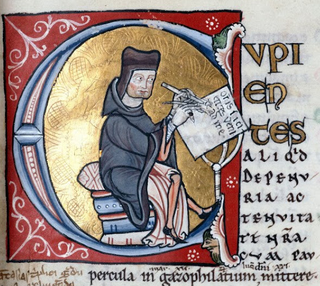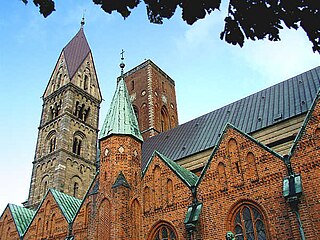
Martin of Dacia (Martinus Dacus, Martinus de Dacia, Morten Mogensen, c. 1240 - 10 August 1304) was a Danish scholar and theologian. He authored De Modis significandi (ca. 1270), an influential treatise on grammar. [1] [2]

Martin of Dacia (Martinus Dacus, Martinus de Dacia, Morten Mogensen, c. 1240 - 10 August 1304) was a Danish scholar and theologian. He authored De Modis significandi (ca. 1270), an influential treatise on grammar. [1] [2]
Morten Mogensen was born at Ribe in Jutland probably in the late 1240s or early 1250s. Mogensen received his theological doctorate in Paris where he obtained the degree of a Magister artium and Magister theologiae. From the 1290s, he held a Prebendary as Canon of the Ribe Cathedral in the Ribe diocese as well as Provost of Schleswig and Canon of Lund. In Schleswig, Mogensen established a vicarage in the parish of Sywertmanrip. [3]
Mogensen was mentioned in 1288 as royal chancellor of Danish King Eric VI Menved (reign 1286 –1319). In the dispute between Jens Grand, Archbishop of Lund, and King Eric VI Menved, Mogensen arranged a royal rapprochement to Pope Boniface VIII, which in 1302 resulting in a settlement of the dispute. In 1302 he gave a donation to the chapter of Notre Dame in Paris. He founded an altar for the cathedral in Roskilde in 1303. Mogensen died during 1304 in Paris and was buried at Notre Dame. [4] [5] [6] [7]
The rendering of his name, Morten Mogensen, into Medieval Latin as Martinus de Dacia stems from the fact that, during the Middle Ages, Dacia was the name of the ecclesiastical province covering the entire Nordic region. [8]

Eric VI Menved was King of Denmark (1286–1319). A son of King Eric V and Agnes of Brandenburg, he became king in 1286 at age 12, when his father was murdered on 22 November by unknown assailants. On account of his age, his mother ruled for him until 1294.

Peter Lombard was an Italian scholastic theologian, Bishop of Paris, and author of Four Books of Sentences which became the standard textbook of theology, for which he earned the accolade Magister Sententiarum.
The Modistae, also known as the speculative grammarians, were the members of a school of grammarian philosophy known as Modism or speculative grammar, active in northern France, Germany, England, and Denmark in the 13th and 14th centuries. Their influence was felt much less in the southern part of Europe, where the somewhat opposing tradition of the so-called "pedagogical grammar" never lost its preponderance.

The Archdiocese of Paris is a Latin Church ecclesiastical jurisdiction or archdiocese of the Catholic Church in France. It is one of twenty-three archdioceses in France. The original diocese is traditionally thought to have been created in the 3rd century by St. Denis and corresponded with the Civitas Parisiorum; it was elevated to an archdiocese on October 20, 1622. Before that date the bishops were suffragan to the archbishops of Sens.

The Archdiocese of Reims or Rheims is a Latin Church ecclesiastic territory or archdiocese of the Catholic Church in France. Erected as a diocese around 250 by Sixtus of Reims, the diocese was elevated to an archdiocese around 750. The archbishop received the title "primate of Gallia Belgica" in 1089.

Jens Grand, the Firebug was a Danish archbishop of Lund (1289–1302), titular Archbishop of Riga and Terra Mariana (1304–1310), and Prince-Archbishop of Bremen, known as the central figure of the second ecclesiastical struggle in Denmark in the late 13th century. He was an outstanding jurist of canon law.
Boetius de Dacia, OP was a 13th-century Danish philosopher.

The Diocese of Meaux is a Latin diocese of the Catholic Church in France. The diocese comprises the entire department of Seine-et-Marne. It was suffragan of the Archdiocese of Sens until 1622, and subsequently of Archdiocese of Paris.

The Diocese of Tulle is a Latin Church diocese of the Catholic Church in Tulle, France. The diocese of Tulle comprises the whole département of Corrèze.

The Diocese of Coimbra is a Latin Church diocese of the Catholic Church in Coimbra, Portugal. It is a suffragan of the Archdiocese of Braga.

Jean-Baptiste Count de Belloy was an Archbishop of Paris and cardinal of the Catholic Church.

The former Diocese of Ribe was a Roman Catholic diocese in Southern Jutland, Denmark. The diocese was established in 948, and dissolved in 1536 during the Protestant Reformation. Within the newly established protestant Church of Denmark, the Diocese of Ribe effectively replaced its Roman Catholic precursor.

The Diocese of Nancy and Toul is a Latin Church ecclesiastical territory or diocese of the Catholic Church in France. After a considerable political struggle between Louis XV, Louis XVI, and the Dukes of Lorraine, the diocese was erected by Pope Pius VI on 17 December 1777. The Diocese of Nancy is a suffragan diocese in the ecclesiastical province of the metropolitan Archdiocese of Besançon.

The Diocese of Rodez (–Vabres) is a Latin Church ecclesiastical territory or diocese of the Catholic Church in France. The episcopal see is in Rodez. The diocese corresponds exactly to the Department of Aveyron.
Giovanni Boccamazza was an Italian Cardinal. He was from the Roman nobility, and was a nephew of Cardinal Giacomo Savelli, who had been an important figure in the Roman Curia since his creation as cardinal in 1261.

The Diocese of Nevers is a Latin Church diocese of the Catholic Church in France. The diocese comprises the department of Nièvre, in the Region of Bourgogne.

Jean Lemoine, Jean Le Moine, Johannes Monachus was a French canon lawyer, Cardinal, bishop of Arras and papal legate. He served Boniface VIII as representative to Philip IV of France, and founded the Collège du Cardinal Lemoine, in Paris. He is the first canon lawyer to formulate the legal principle of the presumption of innocence.
Jaromar II, Prince of Rügen was a Slavic nobleman. He was the ruling Prince of Rügen from 1249 until his death.
Tyge or Tuke or Tycho was bishop of the Diocese of Aarhus in Aarhus, Denmark. Tyge completed studies in Paris where he obtained a magister degree. Tyge became bishop of Aarhus with the support of Pope Urban IV and was involved in the ouster of Jacob Erlandsen, Archbishop of the Diocese of Lund. Bishop Tyge was known as a staunch supporter of the Danish kings and was for a period the de facto head of church in Denmark. Tyge died on Samsø on 23 November 1273. His successor was the former arch deacon Peder Aaby who had been Tyge's and king Eric V'a trusted supporter during the conflict with the church.